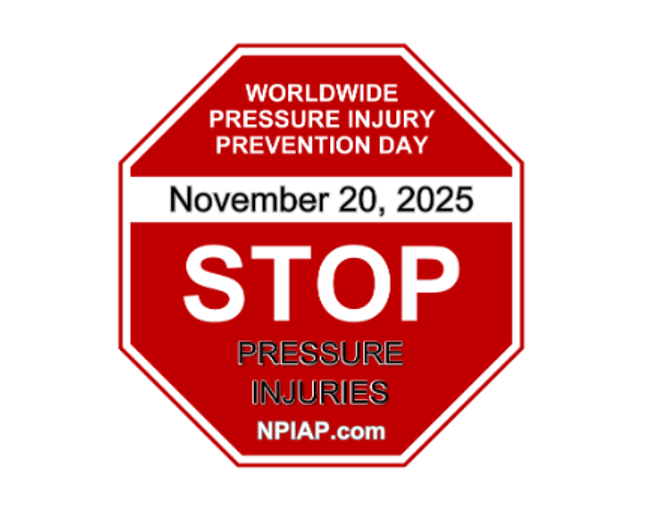The annual Worldwide Pressure Injury Prevention Day is November 20, 2025. Don’t forget that perioperative pressure Injury prevention strategies decrease hospital acquired pressure injuries (HAPIs) in non-reimbursable CMS “never event” category.
Awareness around perioperative pressure injuries and the focus on patient risk identification, including environmental and extrinsic risk factors, is gaining traction within the surgical and medical device community. As a result, skin injury prevention bundles, hospital policies, and safety strategies are researched and recommended throughout the healthcare industry.
Negative effects on patients
Unfortunately, pressure injuries still negatively affect patients by increasing infections, extending hospital stays and contributing to emotional suffering. What’s more, the negative impact of PI does not end with the patient. Hospital systems often become responsible for costly non-reimbursable services related to PI treatments ranging between $20,900 to $151,700 per pressure ulcer.
The average estimated cost of PI to the healthcare industry is $9.1 to $11.6 billion per year in the US. Research suggests that surgery-related pressure injuries may account for 45% of all HAPIs. The highest incidence reported is 54.8%. With the average length of surgery lasting at least three hours, the likelihood of a PI forming also increases by 8.5%.
So why are surgery-related PIs so common? The perioperative/procedural environment exposes the patient to a unique set of extrinsic risk factors that can play a direct role in forming a pressure/skin injury.
Extrinsic risk factors include:
- Type of anesthesia
- Room temperature
- Patient’s position on the operating table
- Table surface
- Devices used
- Shear
- Moisture
- Length of surgery
A 2009 article by Walton-Geer in the AORN Journal reviewed current research on pressure injuries. It stressed the importance of extrinsic (procedure-related) factors that can increase the risk for positioning injury and stressed the importance of preoperative assessment to plan ahead for the use of pressure redistribution support surfaces. Risk identification is the key to decrease incidence of pressure injury in your operating room. Ensure the risk assessment tool your facility is using is a validated tool.
Tools for patient risk assessment
Several assessment tools have been developed to predetermine a patient’s risk for positioning injury. The Braden Scale, Munro Pressure Risk assessment tool and the Scott Triggers tool address pressure injury risk. While the Braden Scale is a validated tool for assessing pressure injury risk for the inpatient population, it is not a validated tool for the perioperative patient. Both the Munroe Scale and Scott Triggers Tools were developed specifically to assess pressure injury risk for perioperative patients.
Evidence-based interventions
Risk must be identified to implement evidence-based practice interventions. This can include gel pads instead of pillows for positioning aids, the use of 5-layer silicone dressings on bony prominences and intraoperative micro-movements for micro-offloading purposes.
In the spirit of pressure injury prevention, celebrate your improved patient outcomes. Revisit your evidence-based perioperative pressure injury bundle to ensure continued improvement for all of your perioperative patients.
In-home care
Pressure injury prevention doesn’t end when patients leave the hospital. For individuals who rely on wheelchairs or spend extended time seated at home, proper pressure management is essential. High-quality wheelchair cushions, repositioning schedules, moisture management, and daily skin checks help decrease the risk of tissue breakdown. Continuing education for patients and caregivers ensures that pressure injury prevention strategies used in surgery and recovery extend into long-term home care. (Gefen et al., 2022; NPIAP, 2023; WHO, 2023).
For additional information on World-Wide Pressure Injury Prevention Day, please visit the NPIAP website.
__________________________________________________________________________________________________
Pressure Injury Prevention Day 2025
AORN Pressure Injury Prevention Recommendations
NPIAP Guidelines
https://internationalguideline.com/
NPIAP Pressure Injury Resources
https://npiap.com/page/FreeMaterials
Support Surface Standards Initiative (S3I Resources)
https://learn.npiap.com/S3IDocuments
Gefen A., et al. Prevention of pressure injuries in the home care environment. Journal of Tissue Viability, 2022. https://doi.org/10.1016/j.jtv.2021.05.005
National Pressure Injury Advisory Panel (NPIAP). Pressure Injury Prevention Resources. 2023.
https://npiap.com/page/FreeMaterials
World Health Organization (WHO). Global guidance on wheelchair provision. 2023.
https://www.who.int/news/item/05-06-2023-who-releases-new-wheelchair-provision-guidelines
Wound, Ostomy and Continence Nurses Society (WOCN). Guidelines for home care pressure injury risk reduction. 2022. https://www.wocn.org/page/pressureinjuryresources
B9063-000






